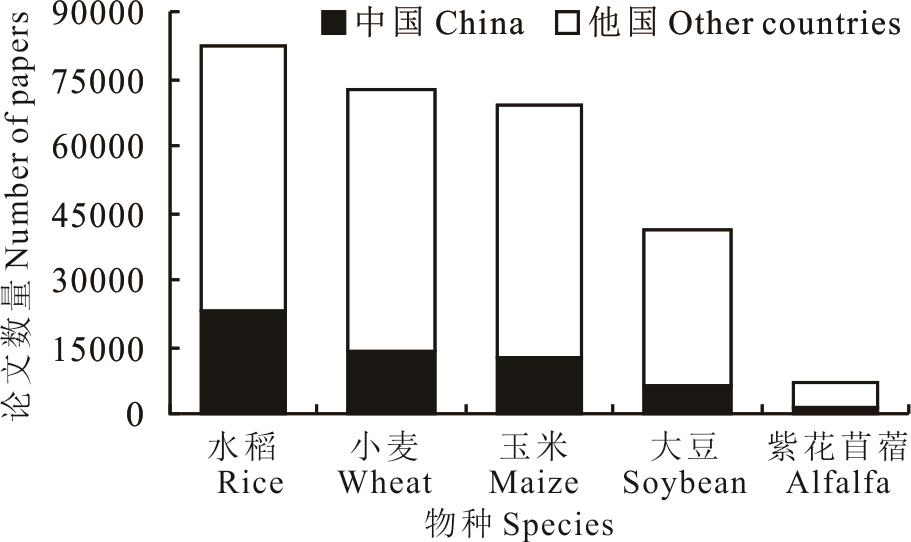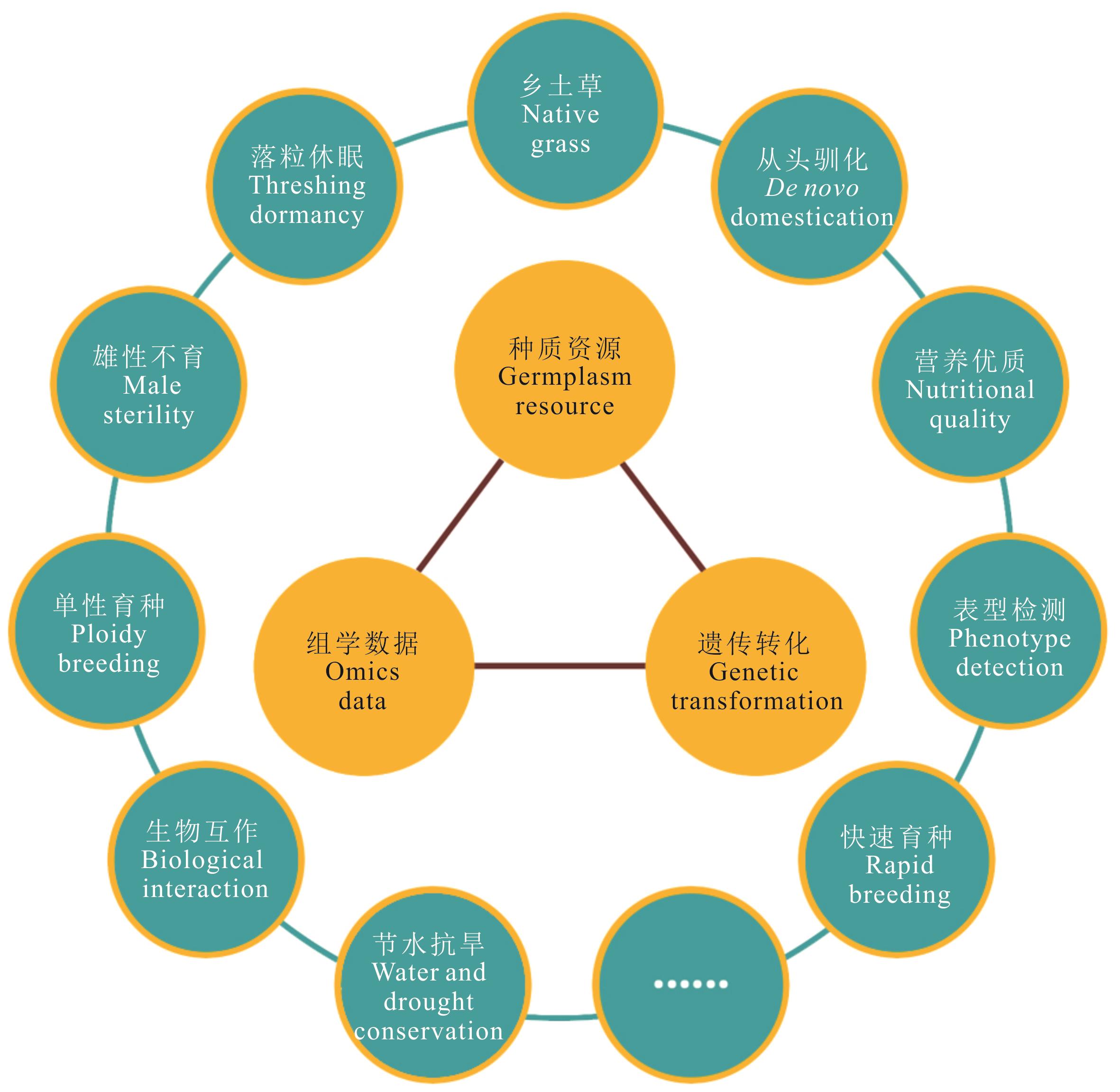

ISSN 1004-5759 CN 62-1105/S


草业学报 ›› 2021, Vol. 30 ›› Issue (12): 184-193.DOI: 10.11686/cyxb2021314
• 综合评述 • 上一篇
刘志鹏( ), 周强, 刘文献, 张吉宇, 谢文刚, 方龙发, 王彦荣, 南志标
), 周强, 刘文献, 张吉宇, 谢文刚, 方龙发, 王彦荣, 南志标
收稿日期:2021-08-19
修回日期:2021-09-22
出版日期:2021-11-11
发布日期:2021-11-11
通讯作者:
刘志鹏
作者简介:Corresponding author.基金资助:
Zhi-peng LIU( ), Qiang ZHOU, Wen-xian LIU, Ji-yu ZHANG, Wen-gang XIE, Long-fa FANG, Yan-rong WANG, Zhi-biao NAN
), Qiang ZHOU, Wen-xian LIU, Ji-yu ZHANG, Wen-gang XIE, Long-fa FANG, Yan-rong WANG, Zhi-biao NAN
Received:2021-08-19
Revised:2021-09-22
Online:2021-11-11
Published:2021-11-11
Contact:
Zhi-peng LIU
摘要:
高产、优质、多抗牧草新品种是我国畜牧业生产的基石,也是我国退化草地补播改良的物质基础,影响国家的食品安全和生态安全。我国牧草育种工作进展缓慢、国际依存度高,已成为农业领域的“卡脖子”问题。近十年,在组学技术和生物技术等的推动下,牧草育种进入快速发展时期,但与主要农作物相比仍有很大差距。本研究综述了未来我国牧草育种发展的3个关键瓶颈:1)种质资源大规模收集、高精细评价与充分利用,包括构建高饱和度突变体库、各类遗传群体等;2)牧草高效再生、遗传转化和基因编辑体系的建立与优化;3)牧草基因组高精度组装与利用,包括基因芯片、全基因组选择等。依据学科前沿和国家需求,笔者展望了今后5~10年我国牧草育种应重点关注的10个科学问题:乡土草资源挖掘与利用、落粒与休眠、雄性不育、倍性育种、生物互作、节水耐旱、从头驯化、营养优质、表型自动化检测、快速育种等,以期为今后的牧草育种相关研究提供参考。这些科学问题的解决,有助于我国尽早培育出一批有自主知识产权的、市场竞争力强的牧草新品种,攻克农业领域的“卡脖子”问题,保障国家的食物安全和生态安全。
刘志鹏, 周强, 刘文献, 张吉宇, 谢文刚, 方龙发, 王彦荣, 南志标. 中国牧草育种中的若干科学问题[J]. 草业学报, 2021, 30(12): 184-193.
Zhi-peng LIU, Qiang ZHOU, Wen-xian LIU, Ji-yu ZHANG, Wen-gang XIE, Long-fa FANG, Yan-rong WANG, Zhi-biao NAN. Some scientific issues of forage breeding in China[J]. Acta Prataculturae Sinica, 2021, 30(12): 184-193.

图1 1990-2020年中国、美国和加拿大发表的紫花苜蓿论文数量比较数据来自“Web of Science”,检索方法是论文题目中含有紫花苜蓿。Data from “Web of Science”, searched by papers with alfalfa in the title.
Fig.1 Comparison of the number of alfalfa papers published in China, the United States and Canada from 1990 to 2020

图2 2001-2020年紫花苜蓿与其他农作物论文数量比较数据来自“Web of Science”,检索方法是论文题目含有相应的物种名。Data from “Web of Science”, searched by papers with corresponding species name in the title.
Fig.2 Comparison of the number of papers on alfalfa and other crops from 2001 to 2020

图3 我国牧草育种的关键瓶颈与主要科学问题黄色背景为关键瓶颈,蓝色背景为主要科学问题。Words in the yellow background are the key bottleneck and words in the blue background are the main scientific issues.
Fig.3 Key bottlenecks and major scientific issues of forage breeding in China
| 1 | Ren J Z. The definition, analysis and relevant description of several professional vocabulary. Acta Prataculturae Sinica, 2015, 24(6): 1-4. |
| 任继周. 几个专业词汇的界定、浅析及其相关说明. 草业学报, 2015, 24(6): 1-4. | |
| 2 | Jin J B, Wang T, Cheng Y F, et al. Current situation and prospect of forage breeding in China. Bulletin of the Chinese Academy of Sciences, 2021, 36(6): 660-665. |
| 金京波, 王台, 程佑发, 等. 我国牧草育种现状与展望. 中国科学院院刊, 2021, 36(6): 660-665. | |
| 3 | Ministry of Agriculture and Rural Affairs of the People’s Republic of China. National alfalfa industry development plan (2016-2020). (2016-12-27) [2021-08-05]. http://www.moa.gov.cn/nybgb/2017/dyiq/201712/t20171227_6129812.htm. |
| 中华人民共和国农业农村部.全国苜蓿产业发展规划(2016-2020). (2016-12-27)[2021-08-05]. http://www.moa.gov.cn/nybgb/2017/dyiq/201712/t20171227_6129812.htm. | |
| 4 | Yang C, Wang G G, Wang M L. Production and trade of wild oat forage in China. Pratacultural Science, 2017, 34(5): 1129-1135. |
| 杨春, 王国刚, 王明利. 我国的燕麦草生产和贸易. 草业科学, 2017, 34(5): 1129-1135. | |
| 5 | National Forage Industry Technology System Office. Trade trends of major grass products, beef and mutton from January to November 2020. (2020-12-27) [2021-08-05]. https://mp.weixin.qq.com/s/LboZQKlDHwjVEum1XskL7Q. |
| 国家牧草产业技术体系办公室. 2020年1-11月主要草产品和牛羊肉贸易动态. (2020-12-27) [2021-08-05]. https://mp.weixin.qq.com/s/LboZQKlDHwjVEum1XskL7Q. | |
| 6 | North American Alfalfa Improvement Conference. Description of alfalfa cultivars and germplasms. (2020-02-06) [2021-08-05]. http://www.naaic.org/resource/cultivar.php. |
| 7 | Huang L K, Feng G Y, Yan H D, et al. Genome assembly provides insights into the genome evolution and flowering regulation of orchardgrass. Plant Biotechnology Journal, 2020, 18(2): 373-388. |
| 8 | Chen H T, Zeng Y, Yang Y Z, et al. Allele-aware chromosome-level genome assembly and efficient transgene-free genome editing for the autotetraploid cultivated alfalfa. Nature Communications,2020, 11: 2494. |
| 9 | Shen C, Du H L, Chen Z, et al. The chromosome-level genome sequence of the autotetraploid alfalfa and resequencing of core germplasms provide genomic resources for alfalfa research. Molecular Plant,2020, 13: 1250-1261. |
| 10 | Li A, Liu A, Du X, et al. A chromosome-scale genome assembly of a diploid alfalfa, the progenitor of autotetraploid alfalfa. Horticulture Research, 2020,7: 194. |
| 11 | Zhang J Y, Wu F, Yan Q, et al. The genome of Cleistogenes songorica provides a blueprint for functional dissection of dimorphic flower differentiation and drought adaptability. Plant Biotechnology Journal, 2021, 19(3): 532-547. |
| 12 | Wang H W, Sun S L, Ge W Y, et al. Horizontal gene transfer of Fhb7 from fungus underlies Fusarium head blight resistance in wheat. Science, 2020, 368: 844. |
| 13 | Yan Q, Wu F, Xu P, et al. The elephant grass (Cenchrus purpureus) genome provides insights into anthocyanidin accumulation and fast growth. Molecular Ecology Resources, 2021, 21(2): 526-542. |
| 14 | Cui J W, Lu Z G, Wang T Y, et al. The genome of Medicago polymorpha provides insights into its edibility and nutritional values as a vegetable and forage legume. Horticulture Research,2021, 8: 47. |
| 15 | Wang T Z, Ren L F, Li C H, et al. The genome of a wild Medicago species provides insights into the tolerant mechanisms of legume forage to environmental stress. BMC Biology, 2021, 19: 96. |
| 16 | Yin M, Zhang S Z, Du X, et al. Genomic analysis of Medicago ruthenica provides insights into its tolerance to abiotic stress and demographic history. Molecular Ecology Resources, 2021, 21: 1641-1657. |
| 17 | Nan Z B, Wang S M, Wang Y R, et al. Stress tolerance mechanisms of 6 native plant species growing in China’s northern grassland and their utilization. Chinese Science Bulletin, 2016, 61: 239-249. |
| 南志标, 王锁民, 王彦荣, 等. 我国北方草地6种乡土植物抗逆机理与应用. 科学通报, 2016, 61: 239-249. | |
| 18 | Gao C X. Genome engineering for crop improvement and future agriculture. Cell, 2021, 184(6): 1621-1635. |
| 19 | Chen Z H, Li X Y, Hong J. Current situation, problems and suggestions for forage germplasm resources conservation in China. Pratacultural Science, 2018, 35(1): 186-191. |
| 陈志宏, 李新一, 洪军. 我国草种质资源的保护现状、存在问题及建议. 草业科学, 2018, 35(1): 186-191. | |
| 20 | Small E. Alfalfa and relatives: Evolution and classification of Medicago. Wallingford: NRC Research Press, 2011. |
| 21 | Wolabu T W, Cong L L, Park J J, et al. Development of a highly efficient multiplex genome editing system in outcrossing tetraploid alfalfa (Medicago sativa). Frontiers in Plant Science, 2020, 11: 1063. |
| 22 | Meng Y Y, Hou Y L, Wang H, et al. Targeted mutagenesis by CRISPR/Cas9 system in the model legume Medicago truncatula. Plant Cell Reports, 2017, 36: 371-374. |
| 23 | Zhang H L, Cao Y P, Zhang H, et al. Efficient generation of CRISPR/Cas9-mediated homozygous/biallelic Medicago truncatula mutants using a hairy root system. Frontiers in Plant Science, 2020, 11: 294. |
| 24 | Luo D, Wang Y R, Liu Z P. Research progress in the biological basis of legume pod dehiscence. Acta Agrestia Sinica, 2015, 23(5): 927-935. |
| 罗栋, 王彦荣, 刘志鹏. 豆科植物裂荚生物学基础的研究进展. 草地学报, 2015, 23(5): 927-935. | |
| 25 | Sheng X B, Tan Y N, Sun Z Z, et al. Using CRISPR/Cas9-mediated targeted mutagenesis of qSH1 reduces the seed shattering in rice. Scientia Agricultura Sinica, 2018, 51(14): 2631-2641. |
| 盛夏冰, 谭炎宁, 孙志忠, 等. 利用CRISPR/Cas9基因组编辑技术定向降低水稻落粒性. 中国农业科学, 2018, 51(14): 2631-2641. | |
| 26 | Chai M F, Zhou C E, Molina I, et al. A class Ⅱ KNOX gene, KNOX4, controls seed physical dormancy. PNAS, 2016, 113(25): 6997-7002. |
| 27 | Chang Z Y, Chen Z F, Wang N, et al. Construction of a male sterility system for hybrid rice breeding and seed production using a nuclear male sterility gene. PNAS, 2016, 113(49): 14145-14150. |
| 28 | Zhang D F, Wu S W, An X L, et al. Construction of a multicontrol sterility system for a maize male-sterile line and hybrid seed production basedon the ZmMs7 gene encoding a PHD-finger transcription factor. Plant Biotechnology Journal, 2018, 16(2): 459-471. |
| 29 | Zheng X L, He L L, Liu Y, et al. A study of male fertility control in Medicago truncatula uncovers an evolutionarily conserved recruitment of two tapetal bHLH subfamilies in plant sexual reproduction. New Phytologist, 2020, 228: 1115-1133. |
| 30 | Wang C, Liu Q, Shen Y, et al. Clonal seeds from hybrid rice by simultaneous genome engineering of meiosis and fertilization genes. Nature Biotechnology, 2019, 37: 283-286. |
| 31 | Li C J, Wang Z F, Chen T X, et al. Creation of novel barley germplasm using an Epichloë endophyte. Chinese Science Bulletin, 2021, 66: 2608-2617. |
| 李春杰, 王正凤, 陈泰祥, 等. 利用禾草内生真菌创制大麦新种质. 科学通报, 2021, 66: 2608-2617. | |
| 32 | Liu Z P. Intermediate trial of trans-Solyc08g016270 gene for disease resistant alfalfa Cu-1 in Gansu Province. Agricultural Genetically Modified Organisms Safety Management Office, Ministry of Agriculture and Rural Affairs, 2020-7-1. |
| 刘志鹏. 转Solyc08g016270基因抗病紫花苜蓿Cu-1在甘肃省的中间试验. 农业农村部农业转基因生物安全管理办公室, 2020-7-1. | |
| 33 | Hou X Y. Spatial-temporal dynamics of climate productivity potential in China from 1951 to 2000. Arid Land Geography, 2008, 31(5): 723-729. |
| 侯西勇. 1951-2000年中国气候生产潜力时空动态特征. 干旱区地理, 2008, 31(5): 723-729. | |
| 34 | Gupta A, Rico-Medina A, Caño-Delgado A I. The physiology of plant responses to drought. Science, 2020, 368: 266-269. |
| 35 | Zhang J Y. Intermediate trial of trans-CsLEA2 and CsALDH12A1 genes for resistance to alfalfa L1 and others in Gansu Province. Agricultural Genetically Modified Organisms Safety Management Office, Ministry of Agriculture and Rural Affairs, 2020-7-1. |
| 张吉宇. 转CsLEA2和CsALDH12A1基因抗逆紫花苜蓿L1等在甘肃省的中间试验. 农业农村部农业转基因生物安全管理办公室, 2020-7-1. | |
| 36 | Bao A K, Du B Q, Touil L, et al. Co-expression of tonoplast Cation/H+ antiporter and H+-pyrophosphatase from xerophyte Zygophyllum xanthoxylum improves alfalfa plant growth under salinity, drought and field conditions. Plant Biotechnology Journal, 2016, 14: 964-975. |
| 37 | Yu H, Lin T, Meng X B, et al. A route to de novo domestication of wild allotetraploid rice. Cell, 2021, 184(5): 1156-1170. |
| 38 | Weng Y, Zeng R, Wu C M, et al. A survey on deep-learning-based plant phenotype research in agriculture. Scientia Sinica Vitae, 2019, 49: 698-716. |
| 翁杨, 曾睿, 吴陈铭, 等. 基于深度学习的农业植物表型研究综述. 中国科学: 生命科学, 2019, 49: 698-716. | |
| 39 | Watson A, Ghosh S, Williams M J, et al. Speed breeding is a powerful tool to accelerate crop research and breeding. Nature Plants, 2018, 4: 23-29. |
| [1] | 赵京东, 乌云娜, 宋彦涛. 短期围封对辽西北退化草地群落牧草品质的影响[J]. 草业学报, 2021, 30(9): 51-61. |
| [2] | 谢文刚, 万依阳, 张宗瑜, 张俊超. 禾本科植物落粒机理研究进展[J]. 草业学报, 2021, 30(8): 186-198. |
| [3] | 赵京东, 宋彦涛, 徐鑫磊, 乌云娜. 施氮和刈割对辽西北退化草地牧草产量和品质的影响[J]. 草业学报, 2021, 30(8): 36-48. |
| [4] | 徐鑫磊, 宋彦涛, 赵京东, 乌云娜. 施肥和刈割对呼伦贝尔草甸草原牧草品质的影响及其与植物多样性的关系[J]. 草业学报, 2021, 30(7): 1-10. |
| [5] | 陶雅, 孙启忠, 柳茜, 李峰, 徐丽君, 李达, 王笛. 先秦时期的牧草栽培利用考述[J]. 草业学报, 2021, 30(5): 200-210. |
| [6] | 彭艳, 孙晶远, 马素洁, 王向涛, 孙磊, 魏学红. 氮磷添加对藏北人工牧草生产性能和品质的评价[J]. 草业学报, 2021, 30(5): 52-64. |
| [7] | 南志标, 王彦荣, 聂斌, 李春杰, 张卫国, 夏超. 春箭筈豌豆新品种“兰箭3号”选育与特性评价[J]. 草业学报, 2021, 30(4): 111-120. |
| [8] | 张茹, 李建平, 彭文栋, 王芳, 李志刚. 柠条枝条覆盖对宁夏荒漠草原土壤水热及补播牧草生物量的影响[J]. 草业学报, 2021, 30(4): 58-67. |
| [9] | 潘发明, 常生华, 王国栋, 郝生燕, 刘佳, 张辉元, 徐银萍. 物候期对放牧牦牛瘤胃液、牧草中脂肪酸及乳脂中共轭亚油酸组成的影响及其相关性分析[J]. 草业学报, 2021, 30(3): 110-120. |
| [10] | 古丽君, 段廷玉. 光叶紫花苕研究状况的文献分析——基于CNKI数据库的文献计量[J]. 草业学报, 2021, 30(11): 221-228. |
| [11] | 牛欢欢, 王森森, 贾宏定, 陈桂华. 光叶紫花苕子浸提液对4种牧草种子萌发过程的化感作用[J]. 草业学报, 2020, 29(9): 161-168. |
| [12] | 张雨桐, 石凤翎. 株型形成及牧草株型相关研究进展[J]. 草业学报, 2020, 29(9): 203-214. |
| [13] | 王锐, 李希来, 张静. 四种覆土处理对高寒煤矿区排土场渣山植被恢复的影响[J]. 草业学报, 2020, 29(7): 40-51. |
| [14] | 雷雄, 游明鸿, 白史且, 陈丽丽, 邓培华, 熊毅, 熊艳丽, 余青青, 马啸, 杨建, 张昌兵. 川西北高原50份燕麦种质农艺性状遗传多样性分析及综合评价[J]. 草业学报, 2020, 29(7): 131-142. |
| [15] | 邱月, 吴鹏飞, 魏雪. 三种人工草地小型土壤节肢动物群落多样性动态及其差异[J]. 草业学报, 2020, 29(5): 21-32. |
| 阅读次数 | ||||||
|
全文 |
|
|||||
|
摘要 |
|
|||||